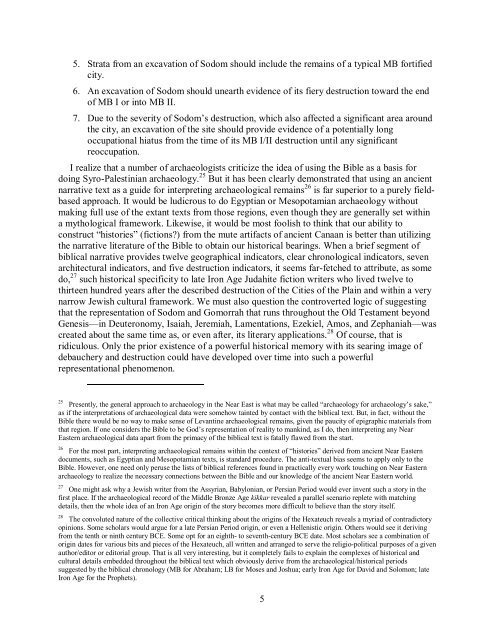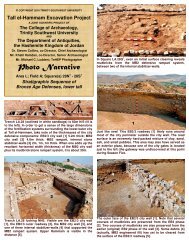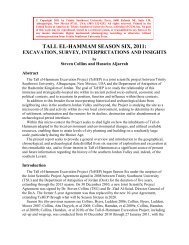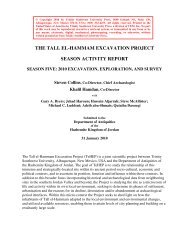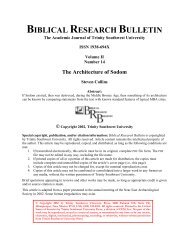Explorations on the - Tall el-Hammam Excavation Project, Jordan
Explorations on the - Tall el-Hammam Excavation Project, Jordan
Explorations on the - Tall el-Hammam Excavation Project, Jordan
Create successful ePaper yourself
Turn your PDF publications into a flip-book with our unique Google optimized e-Paper software.
5. Strata from an excavati<strong>on</strong> of Sodom should include <strong>the</strong> remains of a typical MB fortified<br />
city.<br />
6. An excavati<strong>on</strong> of Sodom should unearth evidence of its fiery destructi<strong>on</strong> toward <strong>the</strong> end<br />
of MB I or into MB II.<br />
7. Due to <strong>the</strong> severity of Sodom’s destructi<strong>on</strong>, which also affected a significant area around<br />
<strong>the</strong> city, an excavati<strong>on</strong> of <strong>the</strong> site should provide evidence of a potentially l<strong>on</strong>g<br />
occupati<strong>on</strong>al hiatus from <strong>the</strong> time of its MB I/II destructi<strong>on</strong> until any significant<br />
reoccupati<strong>on</strong>.<br />
I realize that a number of archaeologists criticize <strong>the</strong> idea of using <strong>the</strong> Bible as a basis for<br />
doing Syro-Palestinian archaeology. 25 But it has been clearly dem<strong>on</strong>strated that using an ancient<br />
narrative text as a guide for interpreting archaeological remains 26 is far superior to a pur<strong>el</strong>y fi<strong>el</strong>dbased<br />
approach. It would be ludicrous to do Egyptian or Mesopotamian archaeology without<br />
making full use of <strong>the</strong> extant texts from those regi<strong>on</strong>s, even though <strong>the</strong>y are generally set within<br />
a mythological framework. Likewise, it would be most foolish to think that our ability to<br />
c<strong>on</strong>struct “histories” (ficti<strong>on</strong>s?) from <strong>the</strong> mute artifacts of ancient Canaan is better than utilizing<br />
<strong>the</strong> narrative literature of <strong>the</strong> Bible to obtain our historical bearings. When a brief segment of<br />
biblical narrative provides tw<strong>el</strong>ve geographical indicators, clear chr<strong>on</strong>ological indicators, seven<br />
architectural indicators, and five destructi<strong>on</strong> indicators, it seems far-fetched to attribute, as some<br />
do, 27 such historical specificity to late Ir<strong>on</strong> Age Judahite ficti<strong>on</strong> writers who lived tw<strong>el</strong>ve to<br />
thirteen hundred years after <strong>the</strong> described destructi<strong>on</strong> of <strong>the</strong> Cities of <strong>the</strong> Plain and within a very<br />
narrow Jewish cultural framework. We must also questi<strong>on</strong> <strong>the</strong> c<strong>on</strong>troverted logic of suggesting<br />
that <strong>the</strong> representati<strong>on</strong> of Sodom and Gomorrah that runs throughout <strong>the</strong> Old Testament bey<strong>on</strong>d<br />
Genesis—in Deuter<strong>on</strong>omy, Isaiah, Jeremiah, Lamentati<strong>on</strong>s, Ezeki<strong>el</strong>, Amos, and Zephaniah—was<br />
created about <strong>the</strong> same time as, or even after, its literary applicati<strong>on</strong>s. 28 Of course, that is<br />
ridiculous. Only <strong>the</strong> prior existence of a powerful historical memory with its searing image of<br />
debauchery and destructi<strong>on</strong> could have dev<strong>el</strong>oped over time into such a powerful<br />
representati<strong>on</strong>al phenomen<strong>on</strong>.<br />
25 Presently, <strong>the</strong> general approach to archaeology in <strong>the</strong> Near East is what may be called “archaeology for archaeology’s sake,”<br />
as if <strong>the</strong> interpretati<strong>on</strong>s of archaeological data were somehow tainted by c<strong>on</strong>tact with <strong>the</strong> biblical text. But, in fact, without <strong>the</strong><br />
Bible <strong>the</strong>re would be no way to make sense of Levantine archaeological remains, given <strong>the</strong> paucity of epigraphic materials from<br />
that regi<strong>on</strong>. If <strong>on</strong>e c<strong>on</strong>siders <strong>the</strong> Bible to be God’s representati<strong>on</strong> of reality to mankind, as I do, <strong>the</strong>n interpreting any Near<br />
Eastern archaeological data apart from <strong>the</strong> primacy of <strong>the</strong> biblical text is fatally flawed from <strong>the</strong> start.<br />
26 For <strong>the</strong> most part, interpreting archaeological remains within <strong>the</strong> c<strong>on</strong>text of “histories” derived from ancient Near Eastern<br />
documents, such as Egyptian and Mesopotamian texts, is standard procedure. The anti-textual bias seems to apply <strong>on</strong>ly to <strong>the</strong><br />
Bible. However, <strong>on</strong>e need <strong>on</strong>ly peruse <strong>the</strong> lists of biblical references found in practically every work touching <strong>on</strong> Near Eastern<br />
archaeology to realize <strong>the</strong> necessary c<strong>on</strong>necti<strong>on</strong>s between <strong>the</strong> Bible and our knowledge of <strong>the</strong> ancient Near Eastern world.<br />
27 One might ask why a Jewish writer from <strong>the</strong> Assyrian, Babyl<strong>on</strong>ian, or Persian Period would ever invent such a story in <strong>the</strong><br />
first place. If <strong>the</strong> archaeological record of <strong>the</strong> Middle Br<strong>on</strong>ze Age kikkar revealed a parall<strong>el</strong> scenario replete with matching<br />
details, <strong>the</strong>n <strong>the</strong> whole idea of an Ir<strong>on</strong> Age origin of <strong>the</strong> story becomes more difficult to b<strong>el</strong>ieve than <strong>the</strong> story its<strong>el</strong>f.<br />
28 The c<strong>on</strong>voluted nature of <strong>the</strong> collective critical thinking about <strong>the</strong> origins of <strong>the</strong> Hexateuch reveals a myriad of c<strong>on</strong>tradictory<br />
opini<strong>on</strong>s. Some scholars would argue for a late Persian Period origin, or even a H<strong>el</strong>lenistic origin. O<strong>the</strong>rs would see it deriving<br />
from <strong>the</strong> tenth or ninth century BCE. Some opt for an eighth- to seventh-century BCE date. Most scholars see a combinati<strong>on</strong> of<br />
origin dates for various bits and pieces of <strong>the</strong> Hexateuch, all written and arranged to serve <strong>the</strong> r<strong>el</strong>igio-political purposes of a given<br />
author/editor or editorial group. That is all very interesting, but it complet<strong>el</strong>y fails to explain <strong>the</strong> complexes of historical and<br />
cultural details embedded throughout <strong>the</strong> biblical text which obviously derive from <strong>the</strong> archaeological/historical periods<br />
suggested by <strong>the</strong> biblical chr<strong>on</strong>ology (MB for Abraham; LB for Moses and Joshua; early Ir<strong>on</strong> Age for David and Solom<strong>on</strong>; late<br />
Ir<strong>on</strong> Age for <strong>the</strong> Prophets).<br />
5


